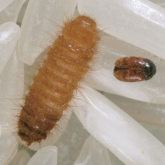Khapra beetle
Alert
Have you seen khapra beetle?
Be on the lookout and report it.
The Australian Government is managing and investigating several khapra beetle detections in imported cargo. Under Queensland legislation if you suspect khapra beetle you must report it immediately to Biosecurity Queensland on 13 25 23.
The Department of Agriculture and Fisheries is working with industry to find ways to address the serious threat posed by khapra beetle to Queensland's agriculture industry. Biosecurity officers are undertaking surveillance and monitoring activities—early detection and reporting are the key elements in controlling this exotic pest species.

Khapra beetle larva and adult on rice grains
© Department of Agriculture, Fisheries and Forestry

Adult khapra beetle, larvae and cast-off skin
© Department of Agriculture, Fisheries and Forestry

Adult khapra beetle, 3mm in length
© Department of Primary Industries and Regional Development Western Australia
Khapra beetle (Trogoderma granarium) is a destructive exotic pest of stored grain, rice and dry foodstuffs worldwide.
The beetle poses a major threat to Australia's grains, dried fruit, rice and nut industries.
Khapra beetles are spread through the movement of infested stored grain and products e.g. flour, breakfast cereals, or as contamination of seed, machinery and straw. They can also hitchhike in shipping containers or other household furnishings.
Khapra beetle is almost identical to the carpet, hide and warehouse beetle and many similar-looking native species in Australia, making it difficult to identify. Microscopic examination or genetic analysis is required to differentiate the species.
Scientific name
Description
Adults
- small (2–3mm long and 1–2mm wide)
- smooth, oval-shaped body
- brownish
- 3 transverse bands (markings) of pale-coloured hairs on the wing cover
- do not fly. Despite having wings, they walk.
Larvae
- appear very hairy, forming distinctive tufts over the body giving the appearance of a short tail
- range in size from 1.6–5mm
- are pale yellow and become golden-brown when grown
- go through 4–7 moulting stages, leaving behind numerous cast skins
- can survive without food for very long periods (over 12 months)
- can survive dormant for up to 8 years in varied conditions.
Identification
Find more:
- images of khapra beetle
- information on identifying khapra beetle.
May be confused with
- Warehouse beetle
- Carpet beetle
- Hide beetle
- Similar-looking native Australian species.
Distribution and habitat
Khapra beetle is well-established in many regions of the world including parts of Asia, Africa, the Middle East and Europe. It prefers hot, dry conditions and will not usually be present outdoors or in damp areas.
Hosts
Larvae feed on grains, seeds and processed vegetable and animal products, including spices, herbs, nuts, rice, dried fruits and dried animal skins.
Khapra beetle can be found in:
- grain and food stores
- malthouses
- seed-processing plants
- fodder-production plants
- dried-milk factories
- stores of packing materials (used or unused sacks, bags, crates)
- kitchen pantries.
Damage
- Can cause significant damage to stored products as the larvae crawl over, eat and contaminate the products.
- Up to 30% of grain can be damaged before it is noticed.
- Cast skins and hair from the larvae contaminate grain, which can be a health risk, and are difficult to remove from grain storage structures and transport vessels.
Monitoring and thresholds
- Khapra beetle is a stored-grain pest. It may be found in stored products and around places where stored products are kept or transported.
- The presence of larvae is usually the most obvious sign of a khapra beetle.
- When examining grain samples, characteristic hairy larvae and cast skins are the most likely to be noticed first.
- It can also be found between cracks and wall linings of storage containers and buildings.
If you suspect you have found khapra beetle, report it immediately to the Department of Agriculture and Fisheries on 13 25 23.
Prevention
Legal requirements
- This is not a declared species under the Land Protection (Pest and State Route Management) Act 2002 but may be declared under other legislation or local government law.
Further information
- Protecting Australia from khapra beetle—Department of Agriculture, Fisheries and Forestry
- Fact sheet on khapra beetle—Plant Health Australia
- Identifying khapra beetle—Department of Agriculture, Fisheries and Forestry
- Images of khapra beetle—Pests and diseases image library (PaDIL)